Scientific Method is in many ways the flip side of the coin to episodes like Nemesis, Distant Origin or Remember.
Nemesis, Distant Origin and Remember were effective demonstrations of Jeri Taylor’s approach to Star Trek: Voyager, a conscious effort to downplay the unique premise of the show in favour of pitching a more generic sort of Star Trek. With that in mind, Nemesis, Distant Origin and Remember constructed powerful allegories to examine pressing contemporary issues through the lens of science-fiction, resulting in episodes that represented one of the most defining aspects of the franchise: the sci-fi-tinged morality play.

Built into Voyager’s DNA.
Not every example of this approach worked as well as those three episodes. Voyager began leaning into this more archetypal and generic Star Trek storytelling at the start of its third season, and the results were quite hit-and-miss. There were certainly brilliant examples in the seasons ahead, like Living Witness or Blink of an Eye. But not every allegory worked as well. Sometimes, the episodes were too didactic, like Critical Care or Repentance. Sometimes, the episodes were too generic, like The Chute. Sometimes, they were just ill-judged, as with Retrospect.
Scientific Method is a very bland and forgettable episode of Star Trek. It is not necessarily bad, but it is also not particularly memorable. In some ways, it demonstrates the limitations of the “generic Star Trek” approach to scripting for Voyager. Without a set of interesting and well-developed characters with strong dynamics in a series with a unique identity, an average episode can feel rather flat.

Give her head peace.
Scientific Method is very much an issue-driven episode of Star Trek. There is something to be said for this approach to prime-time storytelling, using the science-fiction setting of the franchise to construct morality plays that reflect the modern world. Josh Marsfelder has argued that the franchise is effectively “children’s television for adults”, and it’s not an entirely unreasonable description. There is something to be said for having a conceptual space where stories can be used to work through big issues in an abstract fashion.
This is not something unique to Scientific Method, by any measure. The Star Trek franchise has a long history of using metaphors to make philosophical points both broad and specific. This played out even in the context of the franchise’s first season in the mid-sixties. The Devil in the Dark was a broad metaphor about learning not to hate something because it did not conform to expectations or because it was alien, while A Taste of Armageddon was a direct commentary on the news coverage of casualties from the Vietnam War.

Painting a pretty picture.
That spirit of social commentary has become a defining attribute of the Star Trek franchise as a whole, to the point that the radicalism of the original show has been greatly exaggerated. Nevertheless, they are part of the mythology of Star Trek, and it is no surprise that Jeri Taylor’s very aesthetically conservative tenure as executive producer was very invested in these morality plays. The Chute was a commentary on California’s overcrowd prisons. Remember was about Holocaust denial. Distant Origin was about evolutionary theory. Nemesis was about killology.
And so Scientific Method is about illegal and immoral experimentation. It is a story in which the Voyager crew discover that a mysterious race of aliens have been conducting grotesque experiments upon them. The Srivani argue that the ends justify the means, that the horrific suffering inflicted upon the crew leads to a greater good. “Please understand that there’s a purpose to our actions,” Alzen urges Janeway. “The data we gather from you may help us cure physical and psychological disorders that afflict millions. Isn’t that worth some discomfort?”

Spot the difference.
There are obviously any number of historical parallels to be drawn. The spectre of gruesome and sadistic human experimentation inevitably evokes the horrors inflicted by Nazi Germany or Imperial Japan upon their prisoners, whether the grotesqueries of Doctor Josef Mengele or the horrors of Unit 731. This thematic connection makes sense. The Star Trek franchise has historically treated the Second World War as its origin point, in terms of both production and narrative; look at The City on the Edge of Forever or Storm Front, Part I and Storm Front, Part II.
However, there is more to the comparison than the internal logic of the Star Trek universe. The mid-nineties had seen a renewed interest in the horrors of the Holocaust, as demonstrated by high-profile cinematic releases like Schindler’s List or Life is Beautiful. More than that, there was an increasing contemporary awareness of the fact that the iconic American space programme had largely been possible due to the recruitment of Nazi war criminals like Hubertus Strughold that sparked no shortage of controversy.

Heading into danger.
However, the nineties were simply content to revisit the atrocities committed by the Axis powers during the Second World War. There was also a renewed awareness of and engagement with the experiments conducted by the United States government on its own citizens without their consent. In October 1995, President Bill Clinton apologised for illegal radiation experiments conducted without the knowledge or consent of the participants. In May 1997, President Bill Clinton apologised for the Tuskegee Syphilis Experiments.
The broader interest in conspiracy culture drew attention to these horrific breaches of trust, also emphasising experiments such as MK ULTRA that employed drugs and hallucinogens against innocent and unsuspecting parties. This paranoia played out in television shows like The X-Files or Millennium, and in the work of Oliver Stone. Brannon Braga and Joe Menosky made a point to tie this strain of nineties conspiracy culture into Voyager, playing with it in episodes like Future’s End, Part I, Future’s End, Part II, Distant Origin and The Voyager Conspiracy.

Chakotay’s old hat at this.
There are certainly elements of all of these idea bubbling through Scientific Method. However, there are also suggestions of a much more specific and pointed (and contemporary) commentary. The episode alludes to those past horrors and the lessons learned, but it also engages with a hot-button topic of the nineties. Voyager was a show very firmly rooted in its particular cultural moment, anchored more firmly in the nineties than any of its sibling shows. As such, it makes sense that Scientific Method would hit on the nineties anxieties around animal testing.
Animal testing was a hugely contentious issue in the nineties. Over twenty thousand people on Capitol Hill in June 1990 to protest such research. College campuses became hotbeds for these protests and rallies. In February 1992, protestors even opposed General Motors’ killing of animals during road safety tests. By the middle of the decade, there were reports that children in classrooms were being taught about the horrors of animal experimentation. At the same time, major companies were actively looking for alternative research methods.

Power to the people.
During the 1997 election campaign, new Labour published a pre-manifesto pamphlet, New Life for Animals, with plans for “the highest possible standards of welfare in the laboratory”. Who knows whether this was influenced by discussions with the Political Animal Lobby (a campaigning organisation set up by the International Fund for Animal Welfare), which donated ₤1 million to new Labour. But the ideas definitely reflected public discomfort about some aspects of animal experimentation revealed by opinion polls at the time.
The proposal to establish a royal commission to conduct a fundamental review of the necessity and justification for animal experiments was quietly shelved (and perhaps the anger resulting from that broken promise fuelled the rise of extremism in the late 1990s). But, when Labour came to power, the expectations of animal rights groups were high. And the government did move quickly to implement a ban on the use of animals to test cosmetics, alcohol and tobacco products; more funding for research on alternatives; and stricter controls on the use of animals in the production of antibodies for research.
In hindsight, this is remarkable. The issue was absolutely massive in the larger context of the nineties, particularly when combined with other animal rights issues and movements.

Beware helm officers bearing gifts.
The issue of animal experimentation somewhat slipped from the public consciousness at the end of the decade. There are any number of reasons why this might have happened. Most obviously, there were perhaps more pressing concerns at the start of the twenty-first century. Released in 2002, 28 Days Later did an excellent of demonstrating the shift, opening with a botched act of animal rights terrorism that leads to the complete breakdown of civilised society and social order. In that respect, it was an excellent transition from the nineties to the War on Terror.
However, there are other reasons why the issue slipped from debate. In some respects, the protesters and activists won the debate. Companies and governments acknowledged their most damning indictments. Procter and Gamble would end most of their animal testing in July 1999. In 2003, the European Parliament agreed to ban the testing of cosmetics products on animals. That law came into effect in March 2009 and was followed by an even more restrictive law restricting the sale of any cosmetics tested upon animals in March 2013.
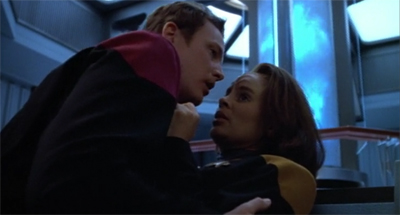
She’ll always have Paris.
It seems fair to argue that the issue was rectified to the extent that it concerned the majority. While animal rights activists are still understandably concerned about the tests conducted on laboratory specimens, it could be argued that the general public have reconciled themselves to the necessity of at least some animal experimentation. In 2006, the People’s Petition garnered national and international attention, a petition representing “the silent majority” of people who acknowledge the importance of such testing.
Animal testing was still a concern when Scientific Method went into production. There are any number of indications that the audience is meant to see the parallels. When Alzen tries to justify her actions, Janeway is having none of it. “What you’re doing isn’t self-defence,” she insists. “It’s the exploitation of another species for your own benefit. My people decided a long time ago that that was unacceptable, even in the name of scientific progress.” Janeway’s choice of “another species” instead of a more specific “sentient beings” suggests animal testing is the focus here.

Massaging the truth.
There are other indications. Most obviously, the Srivani are not portrayed as militaristic or warmongering. Unlike the Nazis or Unit 731 or the CIA, they are not conduct research for tactical use. Instead, Alzen argues that their research will have long-term benefits for ordinary people. “I can understand why you’re angry,” Alzen offers. “I don’t like causing people to suffer, but sometimes it’s a necessary part of my work.” When Janeway asks what work she does, Alzen responds, “Medical research. We’re scientists, like you.”
There is even the faintest trace of commercialisation to the research conducted by the Srivani. When the EMH and Torres conduct their investigation into the alterations made to Neelix and Chakotay, they discover markers on the DNA. Those markers look almost like a barcode. While this inevitably invites comparisons to the numbers tattooed on concentration camp victims, it also suggests a proprietary branding that hints at a more commercial and capitalist dimension to this research. (It also evokes nineties fears about the commercialisation of the human genome.)

Available for $9.99!
To be fair, one of the issues with Scientific Method is that the episode seems didactic and heavy-handed. It feels like a po-faced lecture on animal rights that largely misses the point. Conducting experiments upon human beings is inherently different than experimenting upon animals, because human beings have a fundamentally different sense of awareness. It is not literally and directly comparable in the way that Scientific Method would argue that it is, and so the earnestness feels a little clumsy.
After all, the argument for reducing and minimising animal testing is completely different than the argument for completely avoiding human experimentation, much like there is a sizable difference between arguing in favour of vegitarianism and arguing against cannibalism. If mankind is to reject animal experimentation, it must be with an understanding that pain suffering for any living creature as a direct result of human action is unconscionable. That is a very different argument than recognising the agency and self-awareness of a fellow human being.

This bickering never gets old.
However, there is also a sense that Scientific Method suffers from the generic nature of Voyager as a television show and of these characters as an ensemble. There is a sense that the episode is meant to be about the entire cast. The episode is constructed so that half of the cast are affected by the aliens, which allows for various interactions and exchanges between the crew members. Paris and Torres wonder whether their attraction is simply the result of Srivani experimentation. Neelix and Chakotay wonder who has it worse. The EMH and Seven fight back.
There is just one problem with this. Almost one-third of the way through the show’s fourth season, there is still a sense that these characters are largely cyphers. The conversation between Neelix and Chakotay in sick bay is charming, as the two argue about who got the worst deal. However, this is perhaps the longest single exchange that the two characters have over the entire seven-season run of Voyager. There is no sense that these are two people who have lived together for over three years, so this exchange feels as light as it is charming.

Really digging into it.
This is a general problem with Voyager, and it is a particularly big problem when the show tries to construct stories using the entire ensemble or even subsets of the ensemble. Despite the fact that there are about nine regular cast members, several of those cast members only have one or two key relationships, as opposed to a dynamic nexus. This is perhaps the biggest issue with the Voyager characters and performers, and one that really hobbles the show in its later years. The early seasons did not do enough to flesh out and expand these relationships.
On Star Trek: The Next Generation, Riker has a very different relationship to Picard than to Troi than to Worf. On Star Trek: Deep Space Nine, Bashir gets along differently with O’Brien or Garak or Kira or Dax. In contrast, there is very little unique or interesting about the pairing of Paris and Tuvok or of Chakotay and Neelix. This causes a problem when episodes like Scientific Method try to construct episodes around these characters trapped together facing a common threat.

Doc-ing points for poor characterisation.
Although the problem is only really obvious at this point in the run, it is rooted in the failure of earlier seasons to develop interesting dynamics. There is no reason that Chakotay cannot share an interesting relationship with Tuvok, given their common history. Early episodes suggested that Janeway might be actively invested in the redemption of Paris, but that potential relationship has turned gangrenous. The departure of Kes only causes more severe problems, amputating key relationships for Tuvok and Neelix, who now only have one another.
This is largely a result of how the Voyager writing staff approach the show. The writing staff is singularly disinterested in giving relationship a unique texture, or for developing characters beyond a specific story purpose. This is part of the reason why the experiments with serialisation failed in the second season, with stories like Investigations relying on characters acting in strange and contradictory manners not as an organic extension of who they are, but as a response to what the plot demands.

Scrambling to create interesting dynamics.
Even after that travesty, the writing staff have struggled to learn their lessons. Jeri Taylor has consistently pushed for developing character relationships on the show. While Taylor was a very conservative writer, she did demonstrate and interest in getting the cast to interact. Most obviously, it was Taylor who teased a potential relationship between Janeway and Chakotay, most notably in Resolutions. While that never ultimately went anywhere, it was a character beat that enriched their interactions in later episodes like Scorpion, Part I and Scorpion, Part II.
Similarly, it was Jeri Taylor who pushed for the relationship between Torres and Paris that provides the most organic throughline of Scientific Method and which would become an unlikely source of fascination for the remainder of the show’s run. However, it frequently seemed like Taylor was struggling against the apathy of the rest of the writing staff in developing the show in this direction. It is interesting to wonder whether this was a knee-jerk genre anxiety, similar to the arguments that Deep Space Nine‘s emphasis on relationships made it too “soapy.”
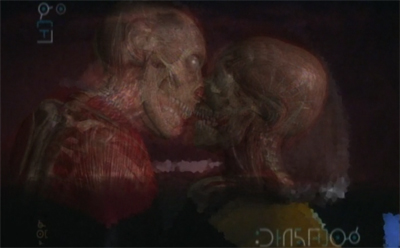
X-ray-ted.
In fact, in an interview with Cinefantastique, future executive producer Brannon Braga vocally objected to a non-utilitarian approach to the relationship between Paris and Torres:
“I’m happy with it in that we have not just done it to do it. We only visit the romance if it serves the story that we’re telling. I thought it worked well in Scientific Method in that it allowed us to see two people kissing with an X-ray machine on, which was pretty creepy. We’ll visit it when it’s relevant to the overall story. We’re not interested in developing a soap opera romance with them. They’re seeing each other. We wanted to show that crewmen get together every now and again. So it’s working well.”
As far as Braga is concerned, the relationship between Paris and Torres is useful only so far is it meets the demands of the story being told. There is something disheartening in that.

Pulsing with passion.
Deep Space Nine used relationships to flesh out its world without sacrificing them at the alter of story. In fact, many of the dynamics on Deep Space Nine seem to have developed almost entirely by chance, from the writers watching the actors interact with one another and playing to those strengths. Deep Space Nine never felt the need to sacrifice those elements to the epic space saga that was unfolding. The epic six-episode opening arc of the sixth season is even bookended by two weddings, of Rom and Leeta in Call to Arms and of Worf and Dax in You Are Cordially Invited…
Voyager would never allow its character dynamics to weave around its storytelling in such a manner, refusing to let character dynamics develop organically by giving its characters breathing room. The series always feels utilitarian in its use of these characters, slotting its regulars into whatever role the plot demands rather than allowing its characters to shape the plot. For example, Tuvok finds himself paired with Paris surprisingly frequently – Ex Post Facto, Worst Case Scenario, Gravity – but without ever saying anything unique about their dynamic.

Yellowshirt, we hardly knew ye.
These problems would arguably only intensify during Brannon Braga’s tenure as executive producer. In fact, some of these tendencies are in evidence with Scientific Method. Most notably, the episode falls back on the idea of Seven of Nine saving the ship from the Srivani. In some ways, this is a reflection of the show that Voyager has become, where even the ensemble episodes must lean heavily into the newest addition to the crew. Seven of Nine is already the show’s most valuable player, despite the fact that she is not even half-way through her first season.
There are other elements of Scientific Method that play into Brannon Braga’s vision of Voyager. Most notably, the episode’s portrayal of Janeway. The third and fourth seasons represent a clear point of transition for the character, away from the more introspective and nerdy commander who appeared in the first two years. In the first few seasons, it seemed like Janeway was a more withdrawn captain, geeking out about pseudo-science in Heroes and Demons and Parallax or retreating to the holodeck alone in Cathexis and Persistence of Vision.

Any which Janeway but loose.
The third and fourth seasons see Voyager reinvent Janeway as a more conventional lead, a consciously “bad ass” captain capable of kicking ass and taking names. This is most obvious in episodes written by Brannon Braga and Joe Menosky, most notably in Janeway’s battle to reclaim her ship from a collection of gigantic viral agents in Macrocosm or through her sheer drive to get the crew home no matter the cost in Scorpion, Part I and Scorpion, Part II. This characterisation also manifests in Year of Hell, Part I, Year of Hell, Part II and The Omega Directive.
There are undoubtedly traces of that in Scientific Method. Although the Srivani have pushed Janeway to the edge of a nervous breakdown, the character pushes back. She throughs Voyager into the middle of a dangerous interstellar phenomenon, urging those malicious scientists to call her bluff. Eventually, the Srivani retreat, although Janeway is committed to her course in both literal and metaphorical terms. She flies the ship between two pulsars, despite the fact that there is only a “one in twenty” chance of survival.

Back to business.
In Yesterday’s Enterprise, Jan Johnson-Smith points to the episode’s climax as a defining moment of characterisation for Janeway:
Without a real family, Janeway demonstrates her willingness to go to extraordinary lengths to preserve her ship and surrogate family in the two-part Year of Hell, refusing to abandon her role as Captain and succumb to medical rest, because ‘right now it [Voyager] needs one of us.’ Her last actions are in fine nautical tradition, she goes down with her ship – finally crashing what remains of Voyager into the Krenim Imperium timeshop (captained by the wonderfully named Annorax), thereby restoring the entire timeline, including Annorax’s former life and love, and Voyager itself. In Scientific Method, Tuvok describes her actions as ‘reckless’ when she heads Voyager between a binary pulsar to shake off aliens who have been conducting medical experiments on the crew. Indeed, although Picard may be explicitly linked to Ahab in Melville’s Moby Dick in the film Star Trek: First Contact, Janeway chares more of his obsessive nature concerning her goals and dedication.
Johnson-Smith makes a very valid point about casting Janeway as a twenty-fourth century version of Ahab. It could be argued that this characterisation is another inheritance from Star Trek: First Contact, along with the Borg.
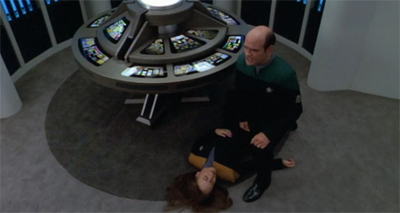
Engineering a solution.
In fact, Scientific Method draws attention to this aspect of Janeway’s personality; to her unwaveirng commitment to protecting her crew. “Don’t forget, we’ve been observing you, Captain,” Alzen notes. “I know the most important thing to you is the welfare of your crew. You’d even kill to protect them.” Janeway acknowledges. “If necessary.” Alzen pushes the point. “Of course you would. You take care of your own, just as we do.” Janeway’s final gambit is just that idea taken to its extreme.
To be fair, it is entirely possible that Lise Klink intended Scientific Method to play as a criticism of the third and fourth season emphasis on Janeway as a memetic bad ass. After all, Janeway’s behaviour at the climax of Scientific Method is not necessarily heroic. It is a decision made after being “awake for four days straight with the constant pain of [Srivani] devices drilling into [her] skull.” In fact, Janeway pointedly goads Alzen, “Well, this is the culmination of your work.” This is very firmly characterised as behaviour that is not healthy.

Hardpressed.
Tuvok and Janeway even acknowledge that this behaviour is out of character for Janeway as she has been established to this point. “This is a far more reckless course of action than I’ve come to expect from you, Captain,” Tuvok states. Janeway agrees, “It certainly is.” However, there is something disconcerting about all of this. After all, Janeway’s deranged behaviour at the climax of Scientific Method is not too far removed from her unwavering and uncompromising commitment to her decisions in episodes like Equinox, Part II.
In Scientific Method, this recklessness and risk-taking is portrayed as out of character for Janeway. However, there are already suggestions that this is to become Janeway’s default, as demonstrated by her willingness to make a deal with the devil to suit her own purposes in Scorpion, Part I and her commitment to preserving that deal at any cost in Scorpion, Part II. It is interesting to wonder whether Scientific Method is perhaps a thinly-veiled criticism of Brannon Braga’s Janeway, as Night might be read of a criticism of Jeri Taylor’s Janeway.
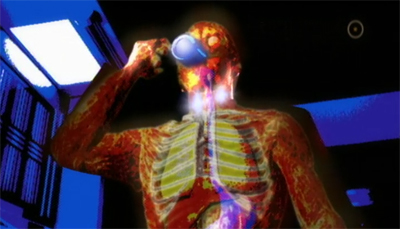
Drinking it in.
One of the more interesting aspects of Scientific Method is the faint accusation that it levels at its audience. While the episode is build around a variety of recognisable Star Trek tropes, it is notable for keeping the Srivani hidden for its entire first half. Instead, the audience is repeatedly put in the position of these sadistic scientists. At various points, the audience is invited to view the data being sent to the Srivani; the kiss between Torres and Paris or the quick cut of Chakotay drinking coffee.
In both cases, the camera does not change position as if to suggest that the audience is repositioning itself into the Srivani perspective. The suggestion seems to be that the camera has always been witnessing the action from the point of view of these mysterious alien visitors. The implication is clear. The audience have always been just as voyeuristic as the Srivani. They have always been spying on the crew in their most private moments. “I just had the feeling that somebody was watching us,” Torres confesses at the end of the teaser. If only she knew.

“I’ve never seen anything like this before… well, except for…”
If this is the case, then Scientific Method could be read as a criticism of its own audience. After all, Voyager is a show that has constantly been subject to network demands and network interference designed to maximise its appeal to the audience at home. The audience might not be directly manipulating Janeway’s dopamine levels, but if the show feels the need to recalibrate the character to satisfy the audience it home, isn’t that just as bad? Given Lisa Klink also wrote the much-tinkered-with Favourite Son, it feels decidedly pointed.
Of course, Scientific Method never develops this idea enough to make a convincing argument. It feels more like a glancing aside. It is a shame, because that small idea has a lot of weight behind it. Instead, a lot of Scientific Method feels reconfigured and rehashed from earlier episodes. If this is “generic Star Trek”, it is Star Trek cobbled together from bits and pieces of other Star Trek episodes. The theme is relatively fresh, and the elements have not been thrown together in this exact manner before, but it is all familiar.
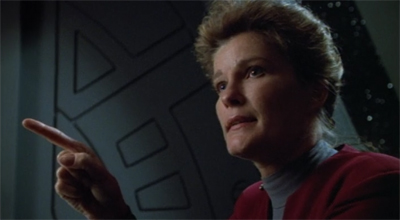
“… a lot of people are spending more time on the holodeck than they are at their posts.”
Okay. Maybe deranged!Janeway has a point.
The idea of aliens conducting experiments upon the crew is a Star Trek standard, dating back to the Viians in The Empath. However, there are shades of other episodes to be found here. A commanding officer who is not quite herself ordering the crew into a dangerous interstellar phenomenon as the result of alien experimentation recalls Allegiance. The entire crew being subjected to experiments without their consent feels lifted from Schisms, although the earlier episode presented the experience in a much more alien manner.
Even the individual afflictions feel lifted from earlier episodes. Paris and Torres possibly being turned into nymphomaniacs by alien interference is very much in keeping with The Naked Now or Fascination. Chakotay aged before his time evokes The Deadly Years or Unnatural Selection or Distant Voices. Neelix finding himself turned into an alien species has echoes of Identity Crisis, although retreating back through his DNA also has shades of Genesis. Janeway being driven insane is in the spirit of The Naked Time.

Not quite one for the ages.
Beyond that, the use of Seven of Nine’s enhanced biology to detect an alien threat evokes Data’s perception of the parasites in Phantasms. There is a sense that Scientific Method is more of a Star Trek mad lib than an episode in its own right, a collection of familiar tropes thrown together around a timely nineties metaphor. At its best, Voyager often felt like archetypal Star Trek, but this simply feels derivative. There are new and interesting ideas here, but they are kept out of focus so the story can invest energy in its more tired beats.
The obvious closing observation is to insist that Scientific Method is a failed experiment, but that is not entirely accurate. There is very little experimental about the episode. If anything, it is too busy validating hypotheses that have already been well tried and tested.
You might be interested in our other reviews from the fourth season of Star Trek: Voyager:
- Scorpion, Part II
- The Gift
- Day of Honor
- Nemesis
- Revulsion
- The Raven
- Scientific Method
- Year of Hell, Part I
- Year of Hell, Part II
- Random Thoughts
- Concerning Flight
- Mortal Coil
- Waking Moments
- Message in a Bottle
- Hunters
- Prey
- Retrospect
- The Killing Game, Part I
- The Killing Game, Part II
- Vis à Vis
- The Omega Directive
- Unforgettable
- Living Witness
- Demon
- One
- Hope and Fear
Filed under: Voyager | Tagged: animal testing, janeway, lisa klink, nineties, star trek, star trek: voyager, voayger |




















I have to give this episode some credit, as it has my favorite comedic Tuvok scene in all of Voyager when he asks Janeway if she would like the crew flogged. I really wish we could have seen more of this Tuvok in the show, rather the one who is constantly tormented by Neelix.
In fact I think one of the biggest missed opportunities in Voyager is that Janeway and Tuvok should have had a really powerful friendship. After all, part of the reason Voyager ends up stuck in the Delta Quadrant is Janeway’s determination to rescue Tuvok. In the end, however, most of the time Tuvok comes off no differently in his relationship with Janeway than say B’Elanna does. One of the most egregious examples is in Unimatrix Zero where Tuvok is succumbing to assimilation, and all Janeway can muster in support is “don’t give in. That’s an order.”
Yeah. I mean, I can understand the marginalisation of Chakotay and Kim to varying degrees. Piller poisoned the well with Chakotay’s New-Age-ism, which meant the writer had no idea what to do with the character after that. Harry is a very “Bashir” character, who is tough to write for; and Garrett Wang is no Alexander Siddig. This lack of attention feeds into the actors’ frustration, which subsequently feeds into disobedience, which feeds into the writers “punishing” the actors by marginalising them further. It’s not particularly professional behaviour from anybody involved, but it makes sense.
The neglect of Tuvok as a character is one of the most disappointing aspects of Voyager. After all, he is the first full-blooded Vulcan character and the character with the strongest pre-existing connections to the rest of the cast; Tuvok has a history with both Janeway and Chakotay, and a unique dynamic with each, he should be easy to write for. Plus, people love Spock. And Tim Russ is solid, if not as good as Mulgrew, Picardo or Ryan.
So it is frustrating to see Tuvok so repeatedly squandered over the course of the run.
I agree. On re-viewing the show as an adult. I feel that Tuvok is by far the most underserved character. I also enjoyed his sudden use of sarcasm and is promise to drink wine with Janeway in her Tuscany simulation. Sadly, this scene was not played out. I would have liked to see Tuvok make some sommelier-level comment on the vintage or something. More lost chances.
In this episode, Janeway’s been awake for several days with an induced migraine and realizes she and her work mates are being used as lab rats.
According to my youtube comments I mean research, this the ep where Mulgrew quit smoking, and she was pretty miserable. After 17 hours without a smoke she used that nicotine fit as a release of fury toward the aliens.
I did not know that, but it makes a certain amount of sense.
I suspect the tension with Ryan may have helped as well.
Yeah, Kate Mulgrew quit smoking during Scientific Method to put herself in Janeway’s irritable frame of mind. It effectively conveyed how unglued Janeway becomes throughout the course of the episode (SM tends to work best when Janeway’s around) and was one of this show’s better ideas.
When I saw Scorpion I observed some deja vu, because it wanted to be VGR’s Best of Both Worlds. But Scientific Method is perhaps even more aware of how far this series lives in the shadow of its predecessors. The episode is a checklist of Star Trek tropes and not just ones about alien experimentation (invisible alien scientists shows VGR is not averse to ripping itself off either).
If this were TNG, Geordi would undoubtedly have been the one to cotton on to the Srivani (he was little more than a walking tricorder in S1), but since this is VGR’s fourth season, that means it’s Seven of Nine (a year ago it would have been the Doctor or perhaps Kes?). It is yet another example of Seven being a strong focus not even halfway through the year (it’s like Wesley Crusher saving the day constantly throughout TNG’s first season).
The Srivani are a real threat to the crew but they don’t seem as interesting as say the Vidiians who also conduct horrific experiments all in the name of scientific progress. The Vidiians feel justified in what they do because the survival of they’re race depends on it, but there’s a very real flaw in the Srivani logic, like what Picard told Data in Descent, Pt II: “How can actions that are wrong lead to a greater good?”
Chakotay and Neelix get a lot of scenes together in Mortal Coil and I think the last one in the Transporter Room ran on longer than the one in Sickbay. The VGR cast is made up of nine regulars, not eight. The name of the Srivani scientist Janeway goads is Takar – Alzen was the one in the Brig (what happened to her at the end?). The aliens in The Empath were called Viians and the Vissians were from the ENT episode Congenitor and have Yellowshirts become the new Redshirts?
It might not be experimental, but arranging well-known tropes can be a lot of fun – and this was definitely it. This show is pretty memorable, at least to me. If I set my mind to “mysterious adventure with pretense of a moral framework” I can and do enjoy it a lot!
Yep. Seasons three and four of Voyager are pretty good at the whole “Voyager as generic Star Trek” thing. Which is ironic, because I’ve heard people complain I’m too hard on the show for being generic. While I’m critical of the way in which that curbed the franchise’s development and how that led to a deterioration in storytelling in the sixth and seventh seasons, I love Distant Origin, Living Witness, Nemesis and so forth.